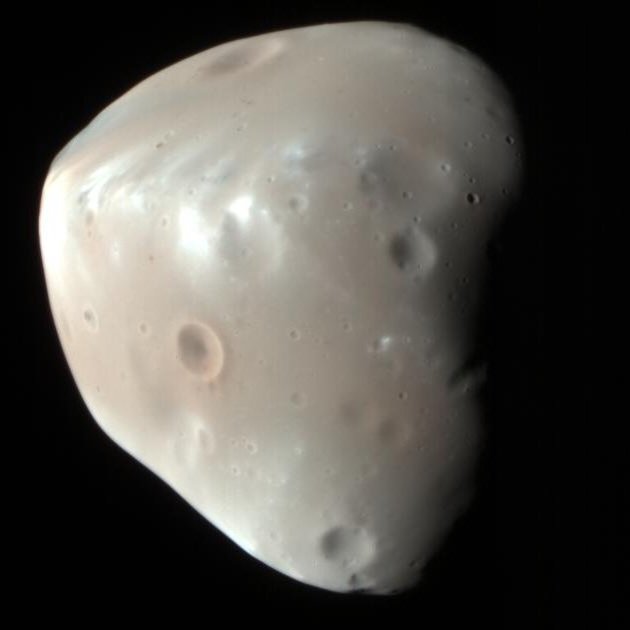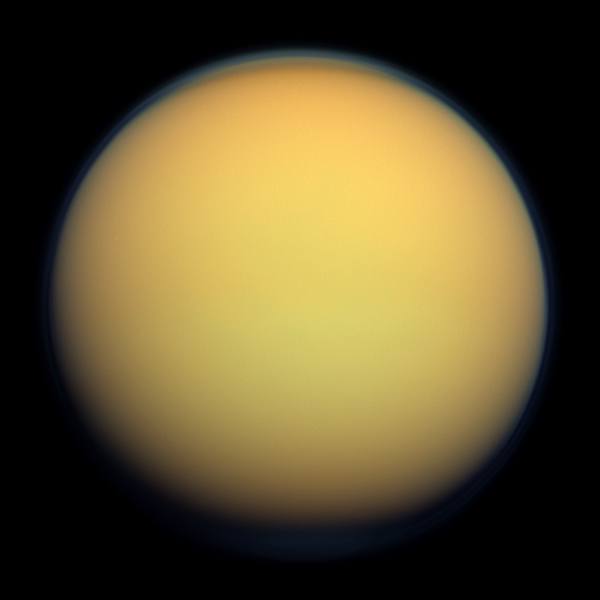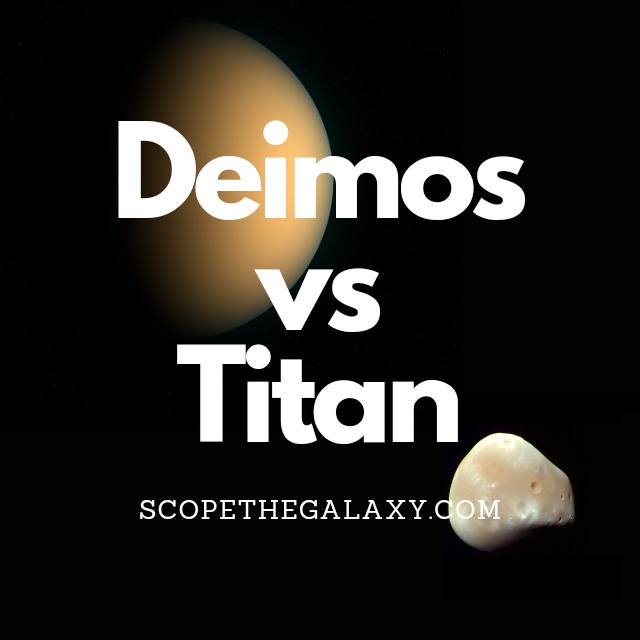*This post may contain affiliate links. This means we may make a commission if you purchase an item using one of our links*
Tha main differences between Deimos and Titan are that Titan is the bigger of the two with a diameter of 5,150km while Deimos’ diameter is 12.4km, Titan orbits Saturn while Deimos orbits Mars and Titan has an atmosphere 1.19 times thicker than Earth’s while Deimos has no atmosphere.
There are various other differences between the two so continue reading for a more detailed look at each body along with their similarities and differences below.
What Is The Moon Deimos?
Table of Contents

Deimos is the smaller and outermost of the two moons of Mars, named after the Greek God of dread and terror (the brother of Phobos). This satellite was also discovered by American astronomer Asaph Hall just five days before Phobos (12th August 1877).
Scientists like Johannes Kepler had put forward theories for the existence of these moons many years before they were discovered. Their calculations were based on the fact that the planets on either side (Earth and Jupiter) possessed one and four moons, respectively.
Still, none were discovered until the 19th century. One of the main reasons for this is that the tiny size of Phobos and Deimos, combined with an exceptionally close orbit to their planet, means that the glare of Mars often obscures our view of them.
Phobos measures just 15 x 12 x 11 km and completes an orbit of Mars once every 30 hours.
This tiny moon is also a heavily cratered landscape shaped by the impact of asteroid collisions over time. However, the material thrown up from these impacts doesn’t appear to have landed back on the moon’s surface as it usually would. This could be because the lack of gravity on Phobos allowed the ejected material into space.
The surface gravity on Deimos is just 0.003 m/s^2 (compared to 9.807 m/s^2 on Earth), which means the average gravitational pull of Deimos is only 0.003 m/s. With only 1/2500th of Earth’s gravity, you would need a tether to walk on this rocky moon, or every step would put you at risk of achieving escape velocity and launching yourself into space.
The composition of Deimos is similar to Phobos, suggesting that it might also be a captured asteroid. Its surface is very dark gray and has an albedo of around 0.07, meaning it reflects just 7% light (about half of the light Earth’s moon can reflect).
What Is The Moon Titan?

Titan is Saturn’s largest moon and the second biggest moon in the entire solar system, with a diameter of 5,150km. This would make it even larger than the planet Mercury which is only 4,879km, and significantly larger than Pluto also.
As a result, Titan’s gravitational strength stands at around 1.352 m/s²
It is the only natural satellite in our solar system that is composed similarly to Earth, where it has a thick atmosphere (1.19 times that of Earth) made primarily of nitrogen (95%) along with smaller amounts of methane (5%).
It has rivers and lakes on its surface along with a water cycle very similar to that of Earth, where essentially water evaporates and eventually lands on the satellites surface.
Therefore, much like Earth, Titan has a terrestrial based body but, there is a difference in their atmospheric pressure. The pressure on Titan’s surface is around 60% greater than that of Earth’s surface but, it isn’t nearly as dense.
Nevertheless, it is still far denser than most other bodies at 1.88 g/cm³. As a result, Titan’s mass is 1.345×10^23 kg.
In regards to its temperature, Titan is on the colder side where it averages around -179 degrees Celsius whilst its core’s temperature is actualluy very cold in comparison to other entities falling between 226 – 526 degrees Celsius.
As Saturn is the 6th farthest planet from the Sun, it will take Titan roughly the same amount of time to orbit the Sun, which would fall around 29.4 years.
It takes Titan 15 days and 22 hours to orbit Saturn. A day is 15 days and 22 hours also as it is tidally locked to the gas giant.
Similarities Between Deimos And Titan
As both are natural satellites, Titan and Deimos do share a few similarities, which include the following:
- Both have a rocky, terrestrial surface.
- Neither have rings surrounding them.
- Both are tidally locked to their planet.
- Both orbit their planet in an elliptical pattern.
- Neither have a magnetic field.
- Neither have tectonic plates.
Differences Between Deimos And Titan
As for the differences between the two, they include the below.
- Deimos orbits Mars whilst Titan orbits Saturn.
- Titan is a spherical shape while Deimos is not.
- Titan has a diameter of 5,150km whilst Deimos has a diameter of 12.4km.
- Deimos has no atmosphere whilst Titan’s atmosphere is 1.19 times as thick as Earth’s and is composed of nitrogen and smaller amounts of methane.
- A day on Deimos takes 30 hours whilst a Titan day takes 15 days and 22 hours.
- It takes Deimos 30 hours to orbit Mars and around the Sun in 687 days whilst Titan orbits Saturn in 15 days and 22 hours and the Sun in 29.4 years.
- Deimos’ temperature ranges between -4 to -112 degrees Celsius whilst Titan’s is around -179 degrees Celsius.
- Titan’s density is 1.88 g/cm³ whilst Deimos has a density of 1.47 g/cm³.
- Titan’s mass is 1.345 × 10^23 kg whilst Deimos’ mass is 1.4762 × 10^15 kg.
- Deimos’ gravitational strength is 0.003 m/s² whilst Titan’s is 1.352 m/s².
- Titan orbits Saturn at an average distance of 1.2 million km whilst Deimos is 24,680km away from Mars
- Titan has a central core while Deimos does not.
- Titan has a water cycle similar to that of Earth whilst Phobos does not have a water cycle.
Summary
Titan and Deimos are both natural satellites that orbit their respective planets and are also tidally locked to their planets but, they differ in numerous ways too.
Whether it be in regards to mass, size, their water cycles, gravitational strength, how dense each body is and more. Therefore, despite the fact both are spherical and rock based celestial bodies, they have many distinct features that allow us to easily distinguish the two from one another.

